Hot Shoe Magazine
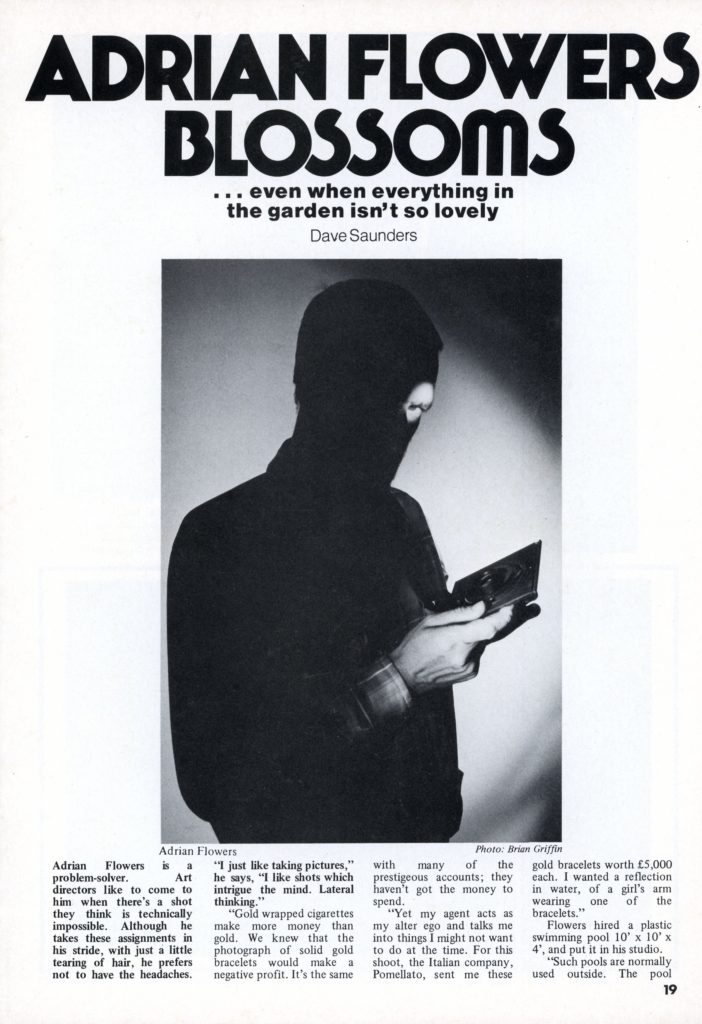

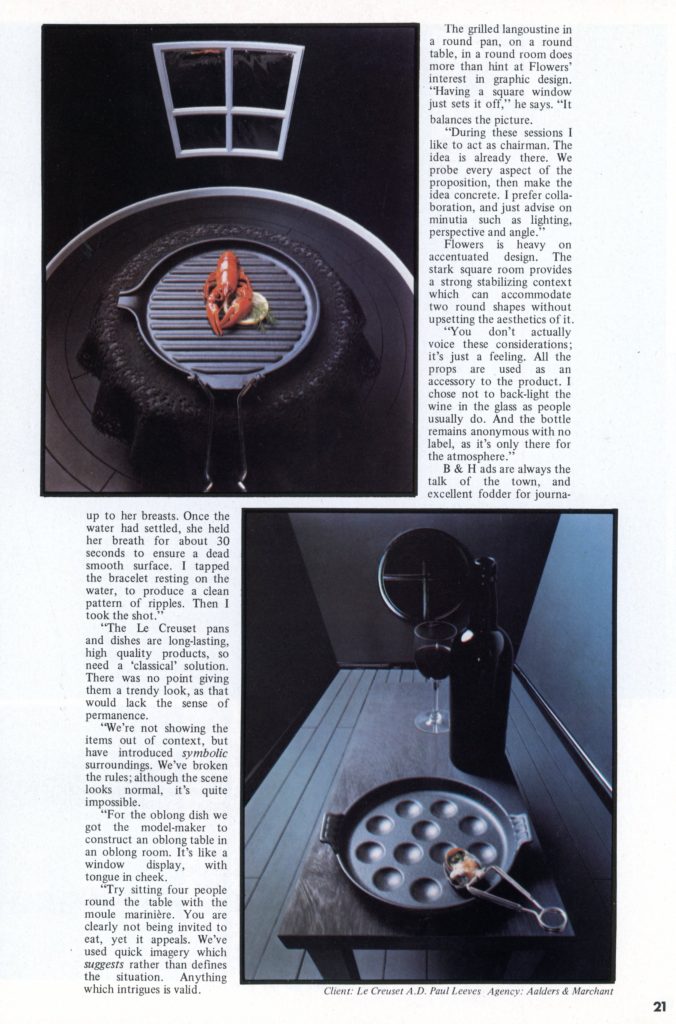
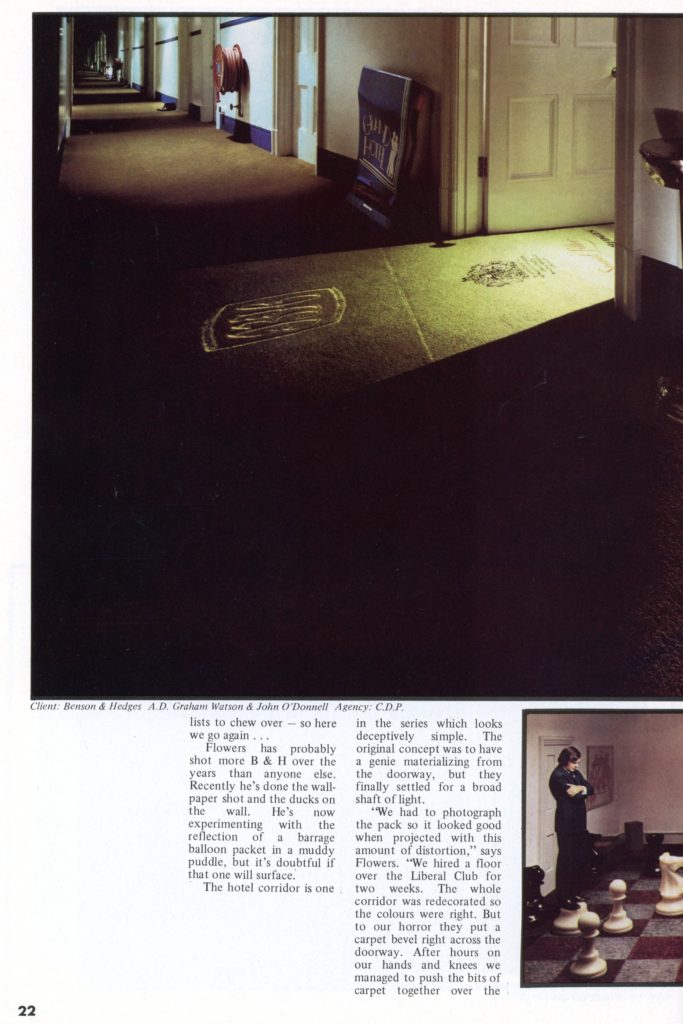
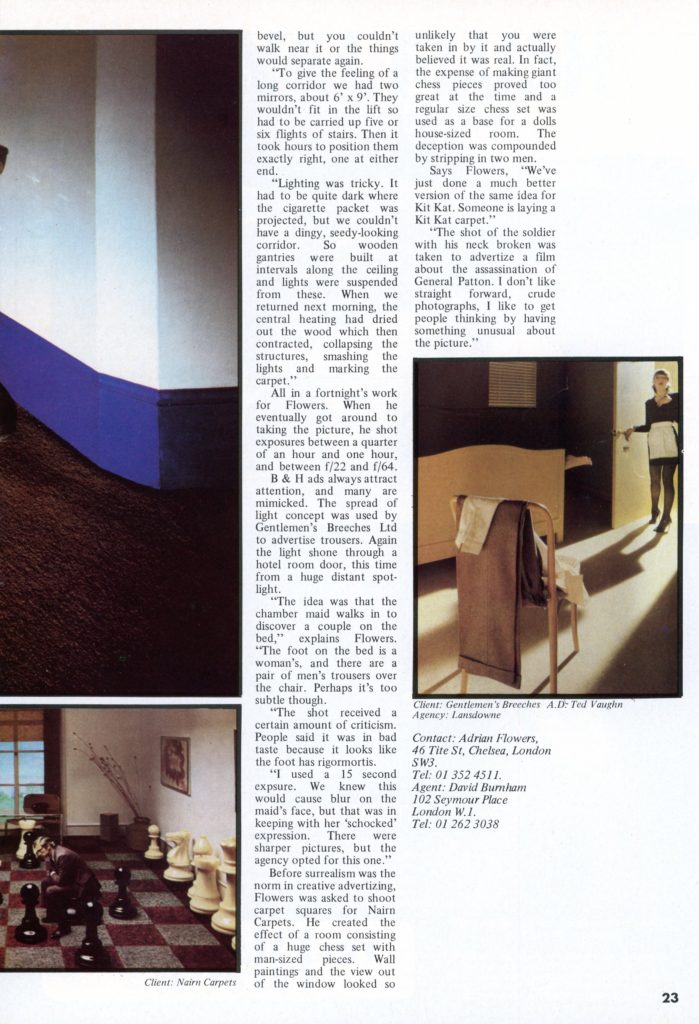
Hot Shoe Magazine





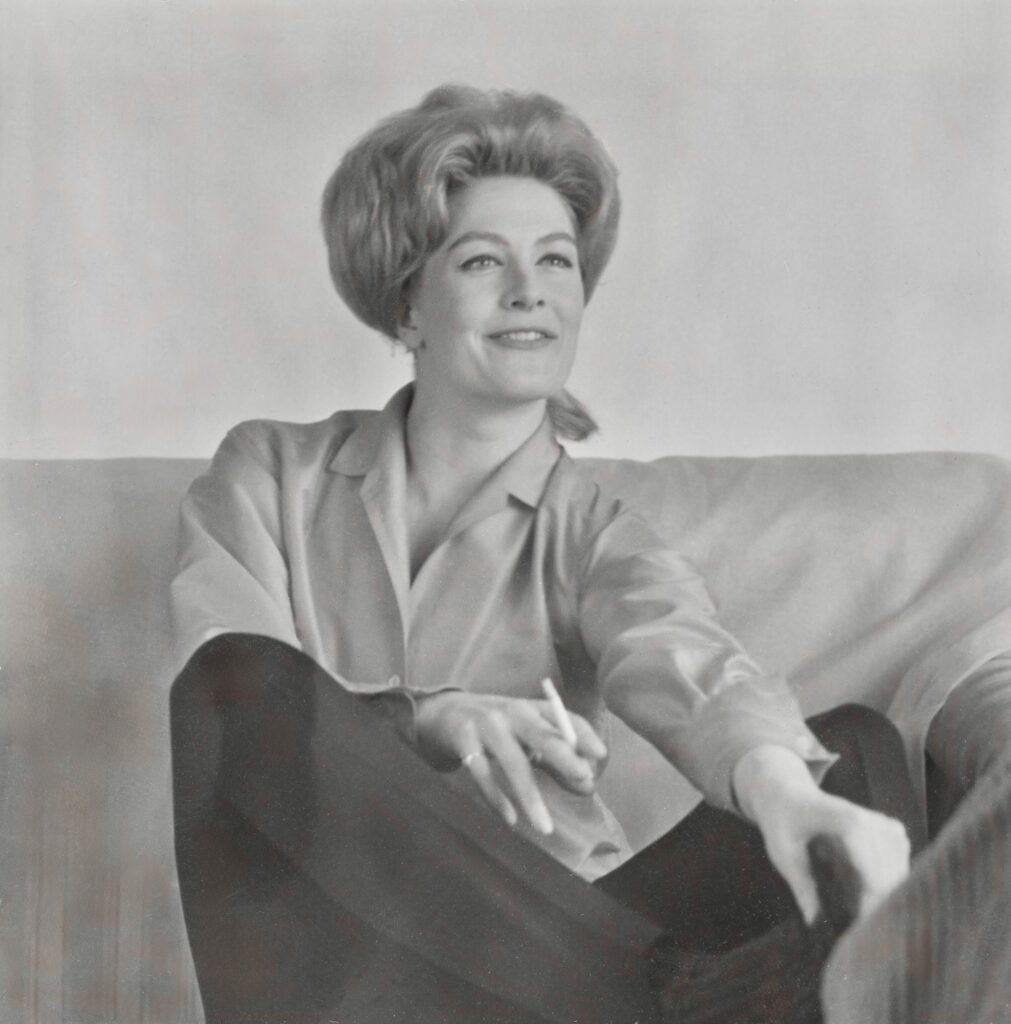
Born in Blackheath in 1937, the actor and activist Vanessa Redgrave comes from a family already famous in the world of stage and screen. The daughter of Sir Michael Redgrave and Rachel Kempson, and sister of Colin and Lynn Redgrave, after studying at the Central School of Speech and Drama, in 1958 she made her stage debut in A Touch of Sun. The following year she appeared in A Midsummer Night’s Dream and two years later was widely praised for her portrayal of Rosalind in the Royal Shakespeare Company’s productions of As You Like It.In 1962, still a rising star in the world of theatre, and by now married to the film director Tony Richardson, Redgrave played Imogen in Cymbeline, directed by Bill Gaskill for the RSC at the Aldwych Theatre. That year she featured in Mademoiselle magazine in the United State, with photographs by Sandra Lousada and was also on the cover of the June 4th international issue of Life magazine, dressed for her role as Rosalind.
On Monday 22nd January 1962, Redgrave’s name appears in the studio diary of the Adrian Flowers studio: “7.30 Flair Vanessa Redgrave 13 Grenvill Pl FRE2591 . . pale yellow walls blue velvet dress”. Judging by the entry, the appointment was for a planned article in Flair magazine. While bearing the same name as the magazine founded by Fleur Fenton Cowles in 1950, the Flair magazine for which Adrian Flowers photographed Redgrave was a quite separate publication, specializing in fashion and beauty as well as feature articles. The diary entry indicates that the photograph session was to take place in Kensington; 13 Grenville Place is just north of Cromwell Road. The twelve photographs taken that evening are all informal, with Redgrave laughing, chatting and posing for the camera. While contact sheet 4169 consists of three strips of four images, making a total of twelve, one of the original negative strips is missing from the AF Archive—perhaps because it was sent to Flair magazine.
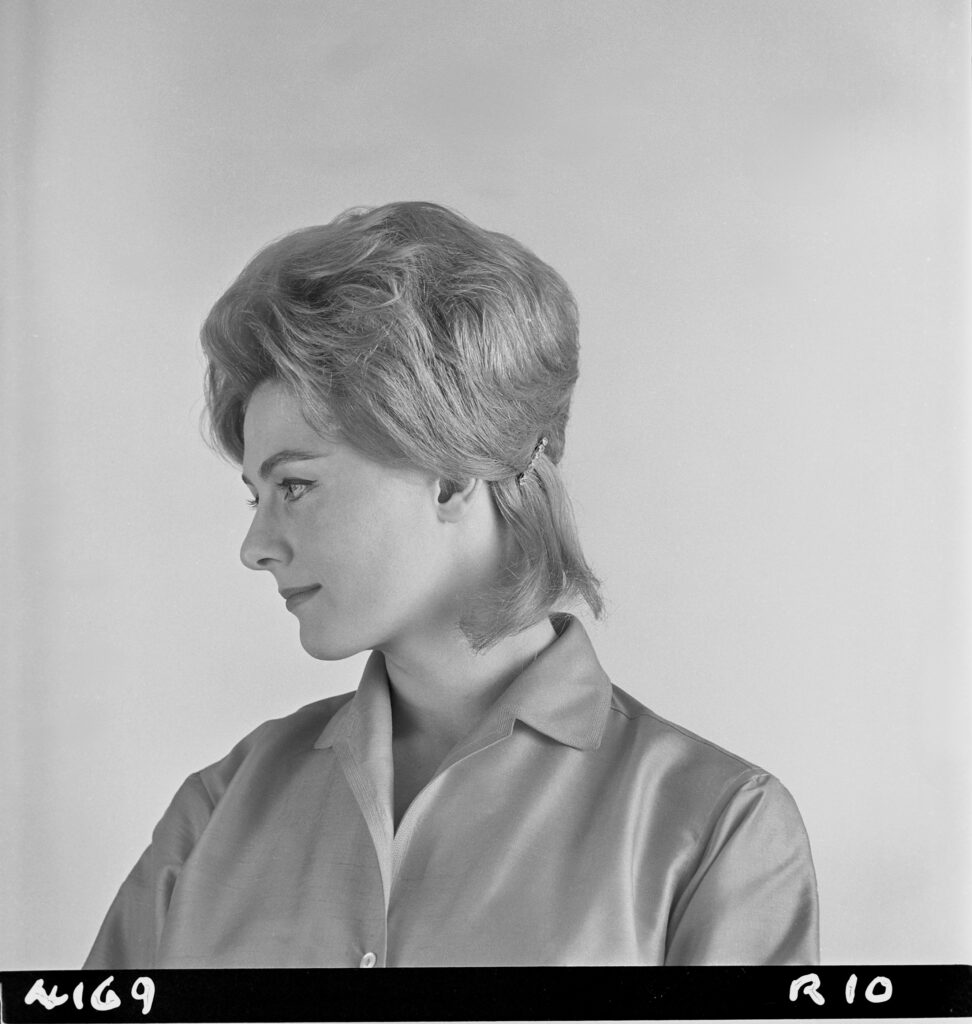
The images are beguiling. A seasoned professional, Redgrave is both relaxed and also aware of the camera, turning her head, smiling, and radiating confidence and a warm human spirit. Since infancy, she had been photographed by some of the top names in photography, including Angus McBean, Yousuf Karsh, George Konig, Paul Tanqueray, and, in 1962, by Tony Eyles. Seven of the photographs by Adrian Flowers are head and shoulders, while the rest show her dressed in a high-necked shirt, with dark slacks and stockinged feet, sitting informally on a couch, legs crossed or feet resting on a low table. She wears no jewellery, little make-up, and her abundant hair is pinned back with a hairclip. The couch has sheets draped over it, to conceal the brightly patterned fabric. In several, she is smoking a cigarette. The background is a plain wall.In a period when portrait photography emphasized fashion, make-up and accessories, these photographs by Adrian Flowers stand out as a record of the person Vanessa Redgrave, direct, honest and fearless, rather than portraying her as a star of stage and screen.
Text: Peter Murray
Editor: Francesca Flowers
All images subject to copyright.
Adrian Flowers Archive ©
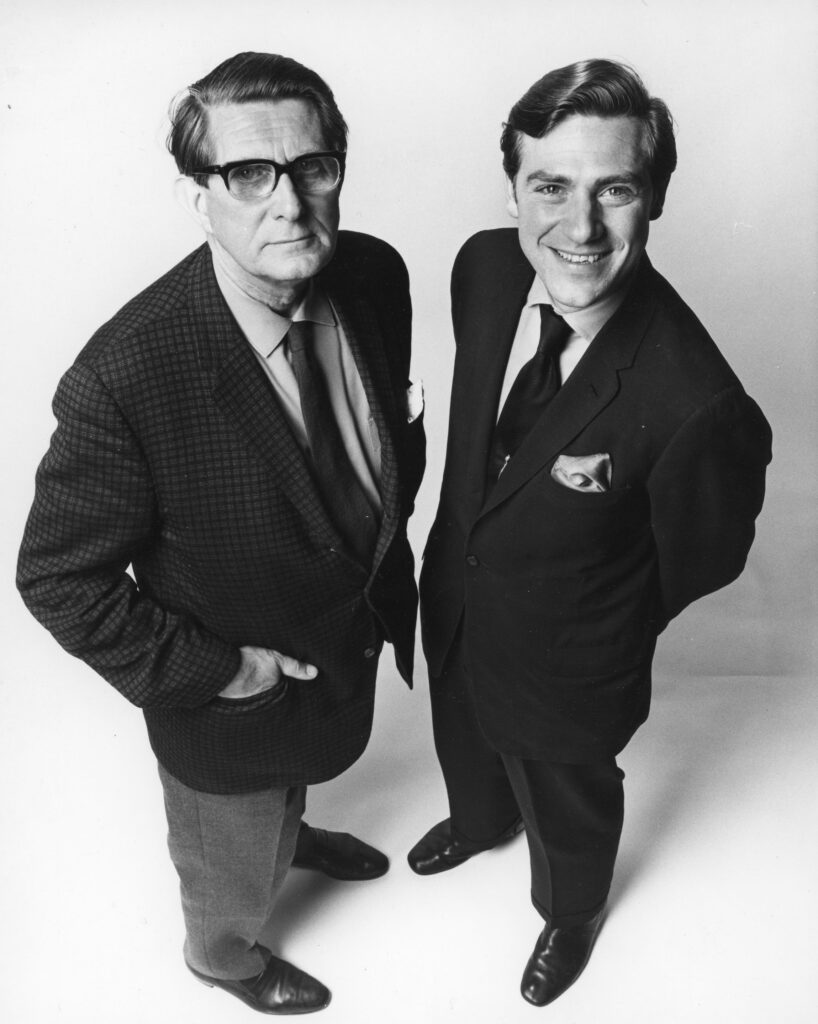
In terms of promoting awareness of Surrealism in mid twentieth-century Britain, the artist and curator Roland Penrose (1900-1984) is a key figure. Born into an English Quaker family, he studied art in Paris and lived for extended periods in the South of France. A friend—and biographer—of both Picasso and Man Ray, Penrose also knew Paul Elouard and a wide range of avant-garde artists and writers. In 1936 Penrose organized the first exhibition of Surrealist art in London, which featured works by Magritte, Man Ray and Max Ernst. With Andre Breton attending the opening and Salvador Dali performing in Trafalgar Square, the resulting press attention had helped spread the fame and notoriety of the movement throughout Britain. Penrose was also a painter, and in works such as Self-Portrait, he represented himself as an embattled figure, an image prompted no doubt by the often mocking press reaction to the exhibitions and events he organized. In the late 1930’s, around the time he and his first wife, the poet Valentine Buoé, divorced, he met the American photographer Lee Miller, who had previously been muse and companion to Man Ray.
In 1947, along with Herbert Read, Penrose was a co-founder of the Institute of Contemporary Arts in London, and twenty years later, as chairman, he oversaw the ICA’s move from its original premises at 17 Dover Street, to Carlton House Terrace, near Buckingham Palace. Key early figures in the history of the ICA include its long-time director Dorothy Morland, the collector Peter Watson, Eduardo and Freda Paolozzi, David Sylvester, Peter Gregory and interior designer Jane Drew. By 1968, Morland had been replaced by Michael Kustow, formerly of the Royal Shakespeare Company, while Penrose’s personal assistant Julie Lawson was now deputy director, a post previously occupied by Brenda Pool, Lawrence Alloway and Jasia Reichardt. When Penrose moved to Paris, to work for the British Council, it left a vacuum, and his role as innovator was taken over by Lawson, Alloway and Morland. With assistance from a trust set up by Penrose, Morland preserved documents relating to the history of the ICA, an archive now held by the Tate.

On June 13th 1968, at his studio in Tite Street, Adrian Flowers photographed Penrose, along with the art critic and curator Mario Amaya. The photographs show the two men, smartly dressed as if for a business meeting. Both are clearly in good humour, relaxed and smiling. In some images, Penrose, the older of the two, is seated on a vintage office chair. Beside him stands Amaya, hair carefully combed and silk handkerchief in breast pocket. The thirty-four year old Brooklyn-born Amaya was also editor of Art and Artists, a magazine he had founded in London three years previously. The photographs clearly relate to the exhibition curated by Amaya, “The Obsessive Image”, which inaugurated the ICA’s tenure at Carlton House Terrace and included works by Andy Warhol, Roy Lichtenstein, Allen Jones, Francis Bacon and David Hockney. The catalogue introduction had been written by Penrose. “The Obsessive Image” finished its run just two weeks before the photo session. There was clearly a close bond between the two men, with Amaya continuing the pioneering work of Penrose, focusing on Pop Art in much the same way as Penrose had promoted Surrealism three decades earlier. Among the artists supported by Penrose were George Hoellering and Penny Slinger—a performance and installation artist whose work was also photographed by Adrian Flowers. A photograph of Roland Penrose, taken by Flowers in 1970, is in the collection of the National Portrait Gallery. Penrose and Lee Miller married in 1947 and lived for many years at Farley Farm in Sussex, where an archive and museum dedicated to their lives and work is maintained by their son Antony Penrose and his daughter Ami Bouhassane.
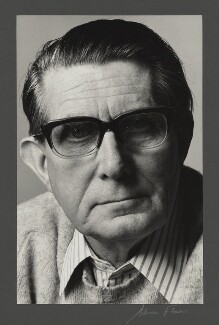
However, the sequence of photographs taken on June 13th 1968 is remarkable for other reasons. Just ten days previously, in New York City, along with Andy Warhol, Amaya had been shot and wounded by a mentally unbalanced woman, Valerie Solanas. While Warhol was critically wounded, the bullet aimed at Amaya had grazed his back without causing any major harm. Discharged from hospital, he was able to return to London for the portrait shoot at Flowers’ studio. Two years later, he was appointed chief curator at the National Gallery of Ontario, and over the following decade, before his premature death from AIDS in London in 1986, Amaya was a popular and charismatic figure in the art world, best remembered for his championing of Pop Art and for publications such as Blacks: USA, Pop as Art, Art Nouveau and Tiffany Glass.
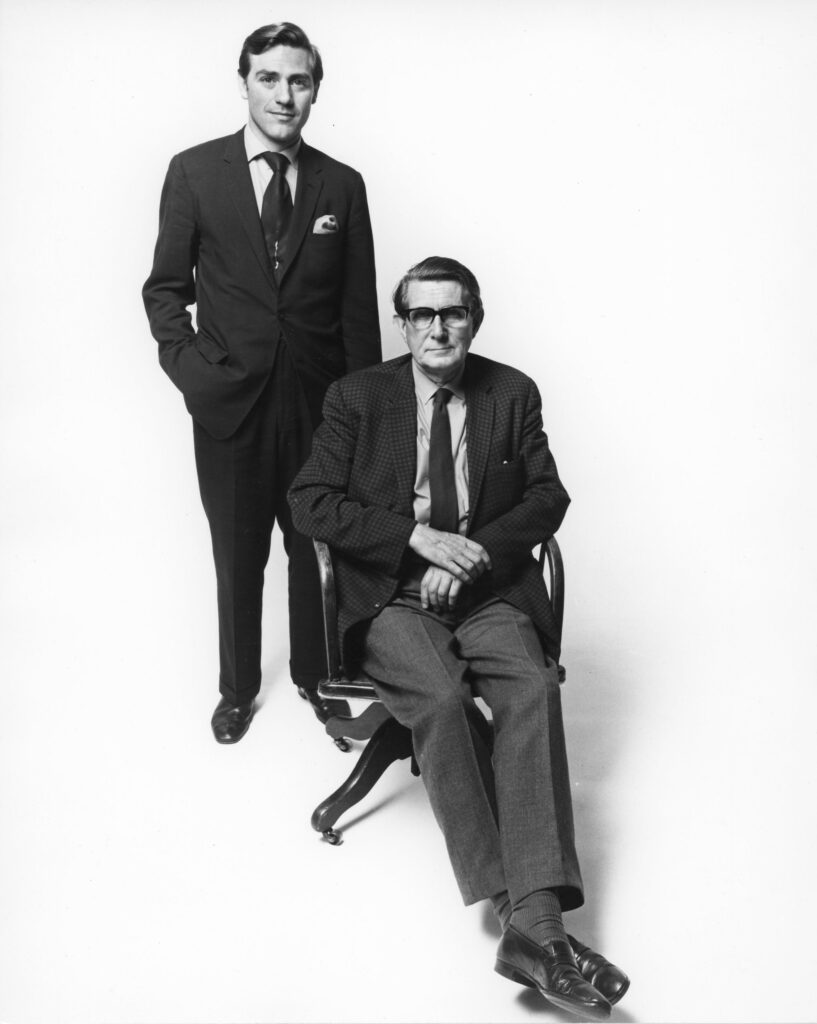
Text: Peter Murray
Editor: Francesca Flowers
All images subject to copyright.
Adrian Flowers Archive ©
Brian Duffy, photographer
1933 – 2010
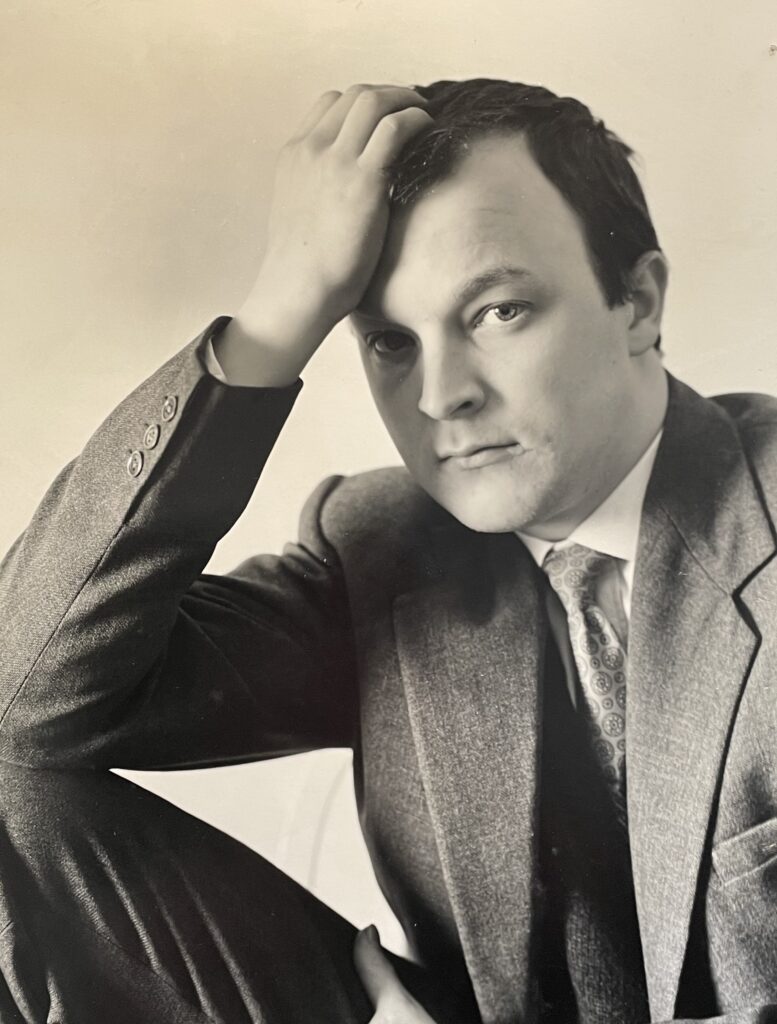
Directed by Linda Brusasco, the television documentary The Man Who Shot the Sixties recounts the life story of Brian Duffy, a portrait photographer famous for his gift of charming, enchanting—and occasionally antagonising—his sitters, but also, more importantly, for his ability to capture superb images on film. In his conversations with colleagues and clients, Duffy could be both funny and caustic, but he was a highly sensitive individual, with an intimate knowledge of the world of fashion and clothing. Famously argumentative, he often found himself in the company of the rich and famous; top models, actors and politicians, but was also on good terms with the London’s East End community, including the notorious Kray brothers. Duffy became one of the top photographers at Vogue, and was later an imaginative director of short films for rock bands, but in 1990 he packed it all in, to set up a furniture restoration workshop in Camden where he worked for the next twenty years. A star during the swinging sixties, along with Terence Donovan and David Bailey, by the turn of the twenty-first century Duffy had faded from public view. Broadcast by the BBC in 2010, The Man Who Shot the Sixties was a timely step in promoting a wider awareness of this remarkable photographer, who had died that same year.
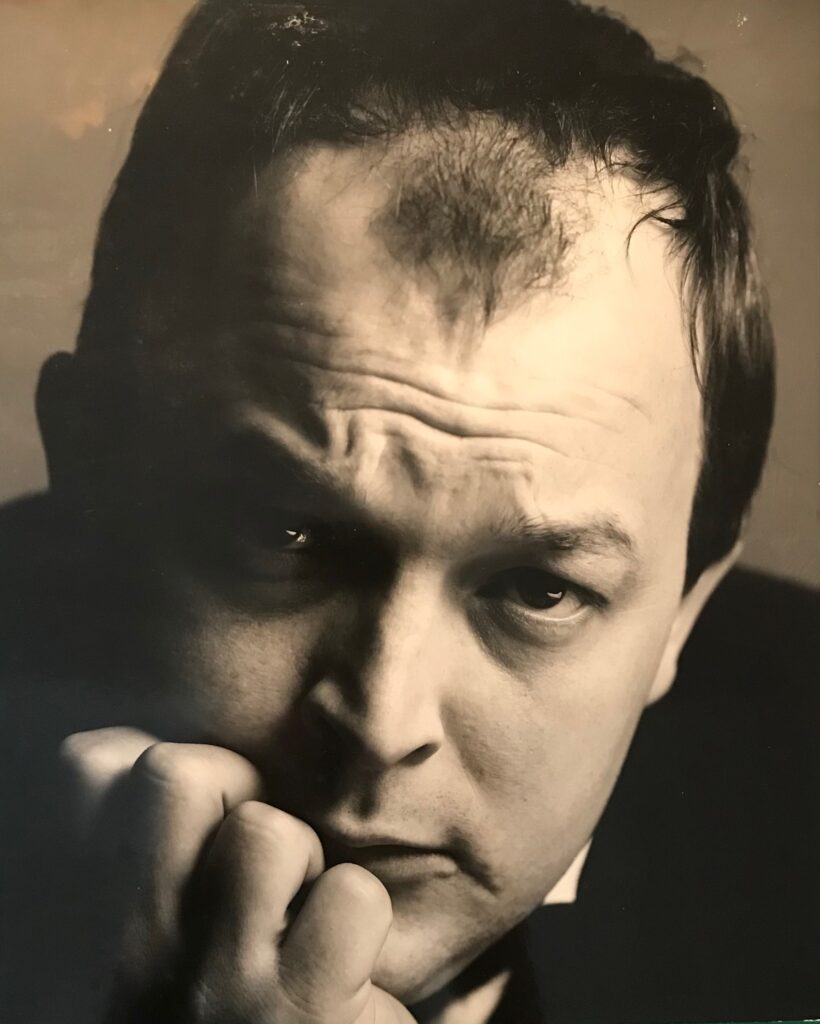
The Adrian Flowers archive includes several sets of photographs of Duffy. The earliest are individual portrait shots taken in January 1958, while the latest date from 1966, and were taken after a celebratory lunch at Alvaro’s restaurant on the King’s Road in Chelsea. In April of that year Duffy had photographed Alvaro Maccioni and his staff at the opening of the new restaurant, an enterprise which immediately rivalled the legendary Trattoria Terrazza in terms of its celebrity and film world clientele. After the lunch, on the spur of the moment, a group including Len Deighton, Duffy, Donovan, and Norman Brand, decided to call in to see Flowers at his studio on Tite Street. Ten years before, a young and inexperienced Duffy had been taken on as assistant photographer by Flowers. Norman Brand had worked for Vogue until 1962, when he joined Duffy at his studio in King Henry’s Road, Primrose Hill. Brand recalls the visit to Flowers: “I don’t know why but as we left it was decided that we would stroll down the King’s Rd and turn left into Tite Street where Adrian had his studio. After the usual chat someone said we should do a group portrait! I have always remembered this occasion and the photo being taken and always regretted never seeing the result but am thrilled to see it after all these years!” A series of photographs, formal and informal, were taken. In several of these, Duffy and Donovan pose together, laughing and joking.

There is also a series of ‘family’ portraits, where everyone assembled good-humouredly in front of the camera. In these, Adrian stands to the right, cable release just visible in his hand. Behind him, wearing spectacles and smiling, is Brand. Deighton is at the back, wearing a white linen jacket, with Donovan to his right. Tousle-headed and with his characteristic impish smile, Duffy is kneeling at the front. He is wearing a tie, as indeed are all the men in the photograph. Donovan looks particularly formal, as if about to attend a funeral. The woman wearing the fashionable trouser suit has not been identified, nor the man in the foreground, leaning on his elbow. The photograph celebrates the culmination of Duffy’s career, when he was launching himself into the world of film production, after achieving fame as a stills photographer.
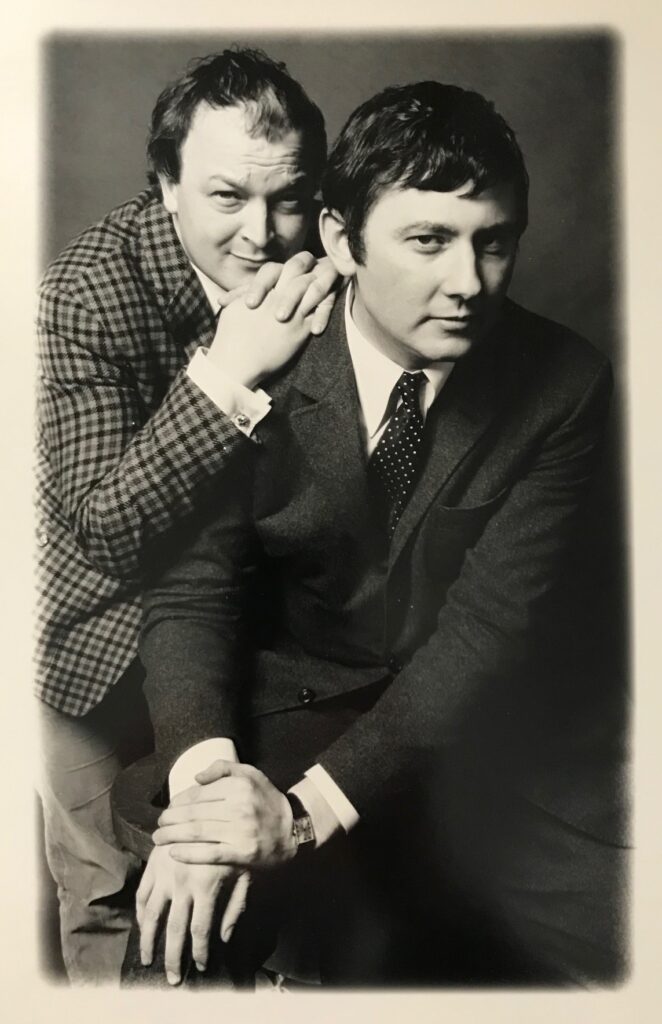
Born in Paddington, north London in 1933, to Irish parents, Duffy grew up in a world defined by conflict, and spent most of his childhood in a city regularly subjected to air raids. During one period of intense bombing he was temporarily evacuated, to the home of actors Roger Livesay and Ursula Jeans. However, through most of the war years he lived in London with his parents. His father, a cabinet-maker, was politically active and at one point had been imprisoned for involvement with the IRA. His mother was from Athlone, had an eye for stylish clothes, and was a devout Catholic. Escaping the confines of a household where religion and Republicanism were closely linked, Duffy and his friends enjoyed the freedom of the city—albeit a freedom tinged with fear—as they explored bomb sites and wrecked houses. Duffy’s parents never moved to the East End. His son Chris Duffy recalls: “my Mum’s parents lived in East Ham and I was brought up there until the age of five, so Duffy’s association with the East End was through my Mum’s side.” David Bailey, five years younger than Duffy, also grew up in this area. A rebellious teenager, often ending up in trouble, Duffy was fortunate to come of age at a time when the recent Butler Act had abolished school fees, opening secondary education to children from working class homes. He was also lucky in attending a progressive school in South Kensington run by ex-servicemen, the purpose of which was to introduce children to a wide range of culture, including opera, galleries and museums.
At the age of seventeen, Duffy enrolled in St. Martin’s School of Art, hoping to become a painter, but, intimidated by the skills and intellectual discussions of his fellow-students, switched to fashion design. At college he met Len Deighton; they formed a life-long friendship. After graduating, Duffy worked for Susan Small, and then for Princess Margaret’s dress designer, Victor Stiebel. Later he worked for Harper’s Bazaar, where the art director Gill Varney showed him how photography and fashion were closely intertwined. Deciding to take up photography, Duffy had a series of short-lived apprenticeships, and a spell at Artist Partners, before being taken on as an assistant in 1956 by Adrian Flowers. Although Flowers came from the same background as did many of the leading photographers of the day—John French had been in the Grenadier Guards, Cecil Beaton had been to Harrow and Cambridge, while Flowers himself attended Sherborne—he recognised and encouraged young talented photographers, irrespective of backgrounds or accents.

Terence Donovan also worked as an assistant in the Flowers studio. During this time Duffy received his first commission, from Ernestine Carter, fashion editor of The Sunday Times magazine. He was a star photographer for this publication for over twenty years, working closely with art director Michael Rand. In 1957 he was hired by Vogue, and grew to admire its editor Audrey Withers, another person willing to take a risk promoting young talent. Duffy loved France and, beginning in 1961, began to spend time in Paris, working for Elle magazine, where Peter Knapp was art director. For Elle he photographed Ina Balke and other models in Parisian street settings, as well as on the Cote d’Azur and Morocco.
Independent, averse to being told what to do, using 35mm cameras and Rolliflexes, working at a fast pace, often in street settings, Duffy, Donovan and Bailey broke many of the conventional rules of photography and were variously referred to as ‘the black trinity’ or ‘the terrible three’. Duffy’s photographs were inventive, with dramatic compositions, often close-cropped. His models, their arms raised in angular poses, sometimes bring to mind the iconography of saints in ecstasy. He was also conscious of cinema, and his photograph of people running underneath cranes could easily be a still from Trauffaut’s 1962 Jules et Jim, while in 1964, his photograph of Celia Hammond, arms outstretched on a street in Florence, could equally be from Kalatozov’s film Soy Cuba, released that same year. This acute visual awareness informs many of Duffy’s images; a model turning and reaching her hand backwards in an open limousine, taken for Town magazine in 1965, recalls the terrified actions of Jackie Kennedy two years earlier in Dallas. Duffy worked for Vogue for six years, photographing Kellie Wilson, Francoise Rubartelli, Jean Shrimpton, Jennifer Hocking, Joy Weston and other top models. Many of the best photographs of Joanna Lumley were taken by him. For Queen magazine he photographed Nicole Da La Marge, Paulene Stone, and Jill Kennington. He also often worked with model Marie-Lise Gres, and in 1962 photographed her at Castletown House in Co. Kildare, a Palladian house being restored by Desmond and Mariga Guinness and the Irish Georgian Society. Duffy also worked for Esquire, the Observer, and The Telegraph, becoming well-known for his portraits. His sitters ranged from politicians to actors, including Harold Wilson, Michael Caine, Ursula Andress, Brigitte Bardot, Nina Simone and Sammy Davis Jnr. At Nova Molly Parkin was another perceptive art director who recognised his talent. For one provocative article “How to Undress for your Husband” the model Amanda Lear posed in states of semi-nudity. Lear had also studied at St. Martin’s and had been a long-time muse of Salvador Dali. Her true gender identity was often the subject of gossip, and she is said to be the inspiration for the character Patsy in Absolutely Fabulous.
In 1966, Duffy was at the peak of his career, when Peggy Roche moved from Elle to become fashion editor of London Life magazine, where David Puttnam, himself the son of a photographer, was managing editor. Duffy took several of the cover photographs for this influential but short-lived magazine. Although the photographs used in Michelangelo Antonioni’s Blow-Up, made that same year, were by Don McCullin, the film was largely based on the work and lifestyles of Duffy, Donovan and Bailey. By the late 1960’s, with Puttnam now his agent, Duffy was moving away from stills photography, and becoming involved with Len Deighton in a film company. The company headquarters were at the bottom of Park Lane, in Piccadilly, the grand offices featuring a partner’s desk, made by Derek Gamble, in the shape of an propeller. Their productions included the 1968 Only When I Larf, and the following year Oh What a Lovely War, films directed by Basil Deardon and Richard Attenborough respectively. The team that travelled to Beirut in 1967 for Only When I Larf included Duffy, Deighton, Brand and Deardon. Having acquired the rights to the musical play Oh What a Lovely War, by Joan Littlewood, Duffy put together a team to film the production on Brighton Pier. However his hopes of directing the film were quashed by trade union regulations so instead he became the producer. Obsessed with World War I, Duffy had an extensive library of books on the topic. He also shot Lions Led by Donkeys a documentary made for Channel 4 about the battlefield of the Somme. David Puttnam’s 1987 film Hope and Glory is a moving depiction of the wartime London in which Duffy had grown up, and which had shaped his attitude to life.
Ever restless, Duffy moved on and began to specialise in more technically-sophisticated photography. In addition to working for the legendary Pirelli calendar, where he used Monaco as the location for his first portfolio in 1965, he photographed the musician David Bowie over a period of several years. The resulting images came to define Bowie’s stage persona, with four being used on album covers, including the 1973 Aladdin Sane. During these years, Duffy also focused on advertising campaigns for CDP, (where Puttnam had also worked), notably those for Smirnoff, Aquascutum, and for cigarette brands Silk Cut and Benson and Hedges, where his surreal visual imagination came into full play. For Aalders Marchant Weinreich he photographed Mary Quant products. He also worked for Biba. However, having conducted the equivalent of a guerrilla war within the elitist world of advertising for almost three decades, in 1990 Duffy retired, to concentrate on the craft of furniture restoration.
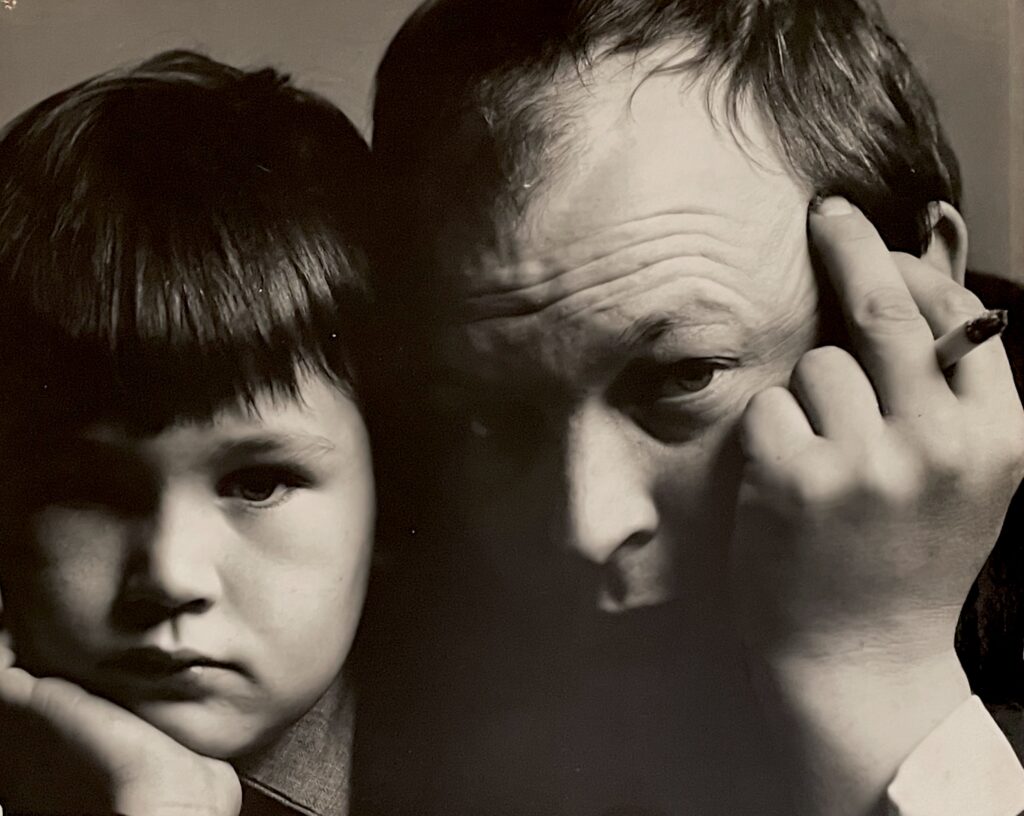
In 2010, two years after his son Chris has founded the Archive that bears his name, Duffy died of pulmonary disease. Unrepentant to the end, he observed “keeping your tongue up the society that pays you is an art of which I was void.” At his funeral the eulogy was delivered by David Puttnam, who observed that ‘the world needs more Duffys’, describing him as a ‘supremely talented and esoteric man . . a man who thrived on risks and challenges, who lived to create.’ Although he had destroyed many of his negatives in the late 1970’s, enough have survived to form a substantial collection. Over the following years, the Duffy Archive has thrived, becoming an invaluable resource of images that define the visual culture of the late twentieth century, and maintaining an online portal for the thirty or so galleries that represent Duffy’s work. Beginning in 2009 at the Chris Beetles Gallery in Mayfair, exhibitions of his photographs have been held around the world. The only showing of his work in Ireland, where both his parents were born and where he was conceived, took place in 2017, at the ebow gallery in Castle Street, Dublin.
Text: Peter Murray
Editor: Francesca Flowers
All images subject to copyright.
Adrian Flowers Archive ©
With thanks to www.duffyarchive.com
1890 – 1956
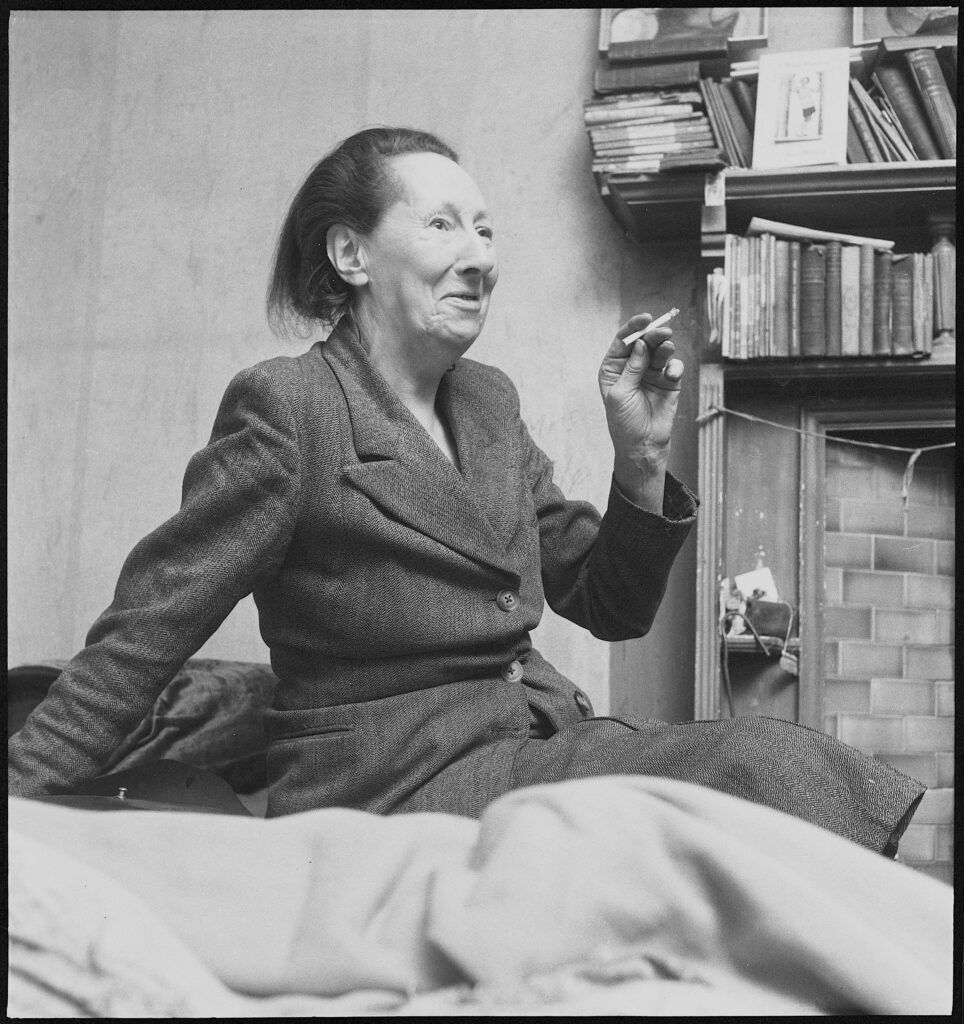
On 7th July 1955, Adrian and Angela Flowers visited the artist Nina Hamnett in her London flat. The photographs Adrian took that evening are among the last visual records of this legendary ‘Queen of Bohemia’. Seated on her bed, Hamnett held forth for her visitors, recounting tales of her life as an artist in Edwardian London and Paris. Cheerful, ravaged, her face like that of an weather-beaten mariner, Hamnett sat, her crutches on the bed beside her. Also on the bed sat a man wearing a vest and smoking a cigarette, his expression thoughtful and pensive. Angela remembers him as a merchant seaman, a friend of Nina’s. There was also a young woman, a journalist. The photographs capture details of Hamnett’s home life, and her love of books and art; above the fireplace were stacked shelves of books, with paintings propped against the wall. A framed drawing of a classical head may have been the same student work for which Hamnett had been awarded a prize, half a century before, at the Portsmouth School of Art. A single candle, on a small footstool beside the fireplace, was likely the only source of illumination when the electricity meter ran out.

In 1955, Hamnett’s second book of memoirs, Is She a Lady?, had just been published, and she was enjoying her time in the limelight. Other photographs taken by Flowers, either on that day or close to it, show her sitting at a bar, with Angela, and also talking to others around her. However, Hamnett’s recollections of her own life were often embellished for literary effect. She told different versions of the same story, and invented episodes, to increase the dramatic effect. She was clearly delighted with the photography session, and dressed up for the occasion.
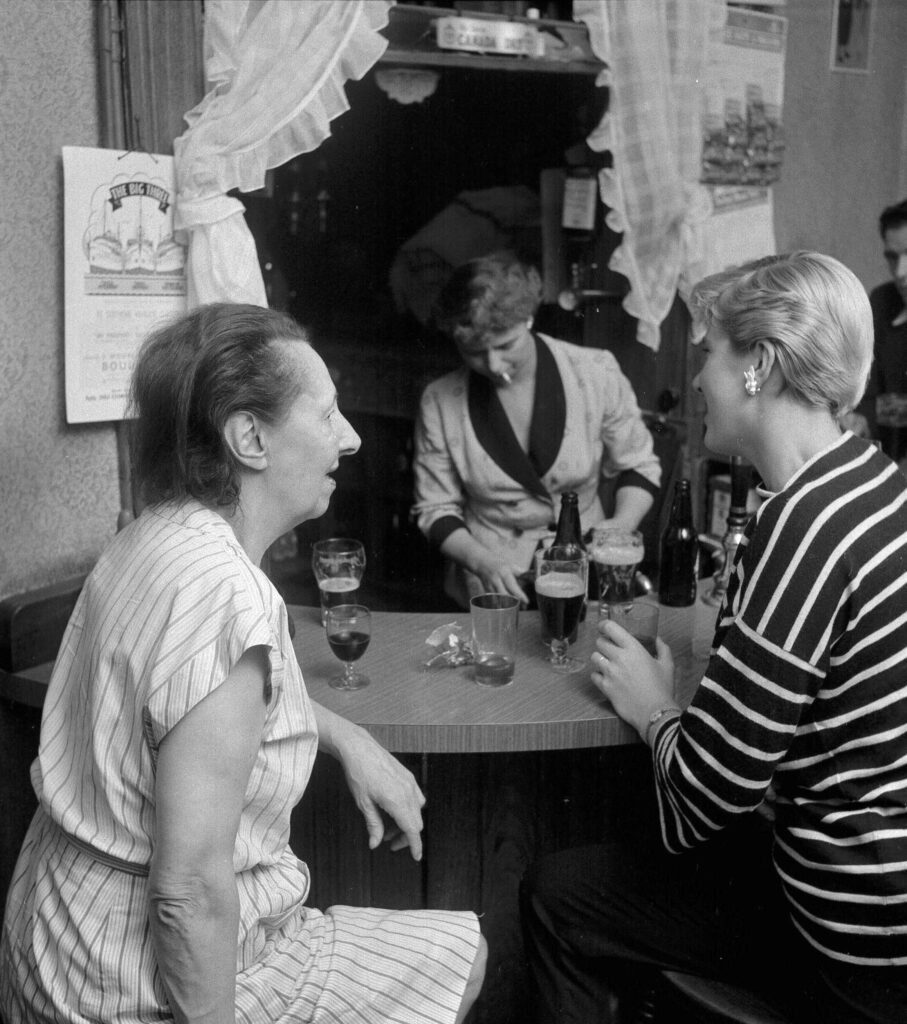
Angela recalls the visit to the bar as having taken place at Little Venice, just north of Paddington Station. The bar was probably in the Bridge House, at Delamere Terrace, close to the Regent’s Canal bridge, an ironwork structure that appears in a 1947 watercolour by Hamnett. In 2019, Kate Thorogood curated an exhibition of Nina Hamnet’s work at the Fitzrovia Chapel, in the course of which she debunked some mythologies, principally the story that Hamnett died in a fall from her flat in Fitzrovia. In fact, Hamnett appears to have moved to Paddington some years earlier: “It is understood that in 1947, there was a fire in her block of flats from which a girl tried to escape by leaping out of the window, only to be impaled on the railings below. Later, Nina would hear this story being told as if she were the one who tragically died. Having been made homeless by the fire and by all accounts refused a place in Marylebone Workhouse, Nina was rehoused in Paddington, not Fitzrovia. It was here she died, also from a fall out of a window. There are many versions of the story of her death, including some in which she dies impaled on the railings. Some claim there was a drunken stumble; others a suicide attempt.” At the time of the Flowers’ visit, Hamnett was just sixty-five, but she was destined to live for just one more year. In 1956, several days after the fall—which was probably accidental—she died in hospital.

Although her death took place in tragic circumstances, Hamnett remains alive in the minds and memories of many, both as a cultural inspiration and a cautionary tale. The story of her life has a stellar quality, but a desire to be the centre of attention led her to forego her own talents as an artist, and to instead become model, dancer, companion, and lover and muse to others, while neglecting her own creative work. Born in 1890, a rackety childhood in Tenby with a grandmother, a couple of years in Ireland with an improvident military father, and teenage forays into London’s bohemia had ill-prepared Hamnett for the conventional career expected of her, of completing a secretarial course, becoming a typist, and settling into suburban life. Having studied at the Metropolitan School in Dublin, then Portsmouth, then the London School of Art, she far preferred the company of sculptors, painters and writers, and, with her hair cut page-boy style and wearing brightly-patterned clothes, enjoyed being stared at by passers-by on the Tottenham Court Road.
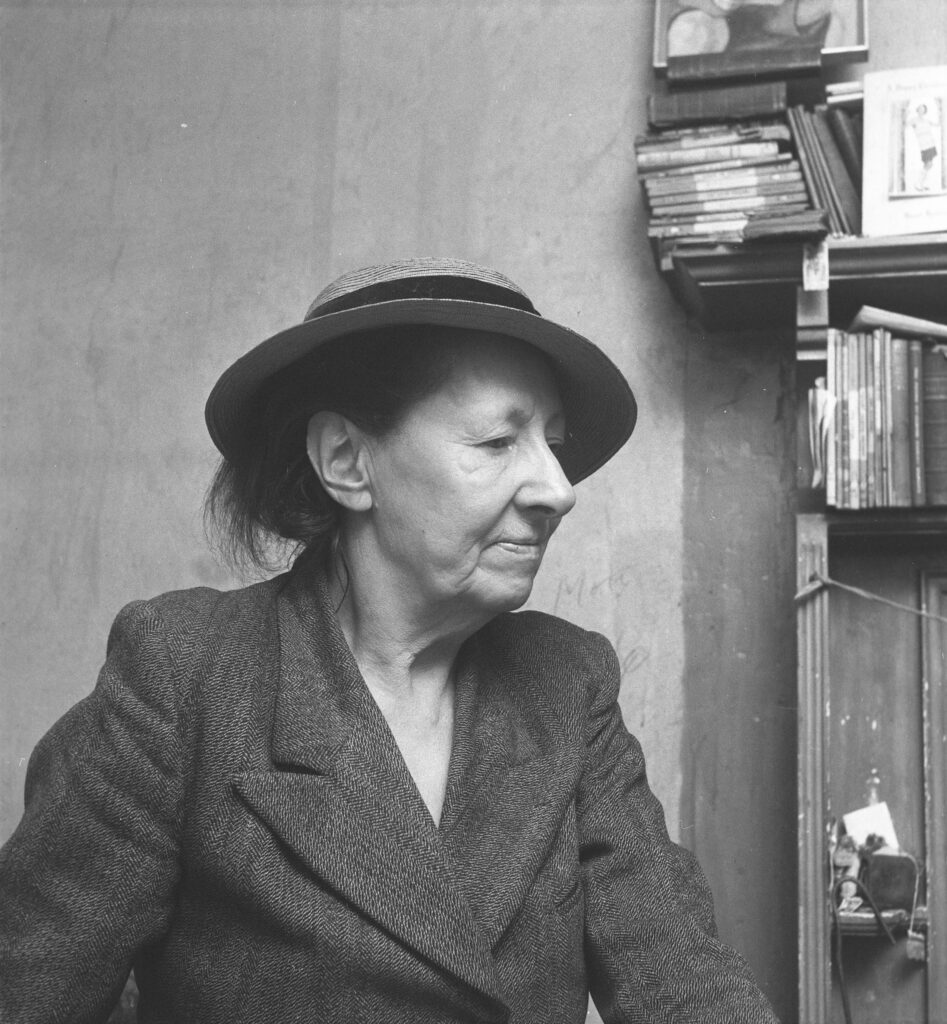
In 1914, at the outset of the First World War, Hamnett was in Paris, hard up, but contriving to remain at the heart of the artistic world that revolved around Montparnasse and La Rotonde. She drank with Zadkine and modelled for Modigliani, in much the same way as, while in London, she had modelled for Roger Fry, Walter Sickert and Henri Gaudier-Brzeska. In Paris, she took off her clothes at parties and, in the manner of Isadora Duncan, danced with a veil, applauded as much by the older women present as by the young avant-garde artists who delighted in this expression of artistic freedom. Although she had male lovers, Hamnett’s friendships with women were often more important to her. She married the Norwegian artist Edgar de Bergen (Roald Kristian) in 1914, but having brought him to England found he was a bore, and was not overly dismayed when he failed to register and was deported back to the Continent as an ‘undesirable alien’. Hamnett then threw herself into the artistic life of London with gusto, dining with Augustus John at the Tour Eiffel restaurant, sketching George Moore and Lord Alfred Douglas at the Café Royal, and working with Roger Fry at the Omega Workshops. In 1917-18 she taught at the Westminster School of Art, and her portraits from these years are among her best. In the 1920’s she moved back to Paris and re-joined the avant-garde, counting Cocteau, Stravinsky and Eric Satie among her friends. These were Hamnett’s most productive years, and she travelled back to London several times to attend openings of exhibitions of her paintings. Two volumes of autobiography preserve the outline, if not the emotional form, of these intense years; published in 1932, Laughing Torso is a window into the avant-garde art worlds of Paris and London, while twenty-three years later, Is She a Lady? brought readers up to date on her spiced-up adventures. Like many of her generation, the First World War had cast a long shadow over Hamnett’s life, and the onset of a second war in 1939 meant that again she could not travel to Paris, and so, over the following two decades, she continued with her bohemian life, holding court at the Fitzroy Tavern in Soho. With alcohol gradually replacing painting, she acquired notoriety, while her friends, in time, disappeared, to be replaced by drinking companions, who to a greater or lesser degree abetted her in this fall from grace. In her formative years, Hamnett’s father, an army officer, had been an overbearing and negative influence, fully expecting his daughter to fail in her determination to live an artistic life. After his death, she went some way towards making up for that disappointment, but remains nonetheless a compelling figure in the world of British avant-garde art.
Text: Peter Murray
Editor: Francesca Flowers
All images subject to copyright.
Adrian Flowers Archive ©
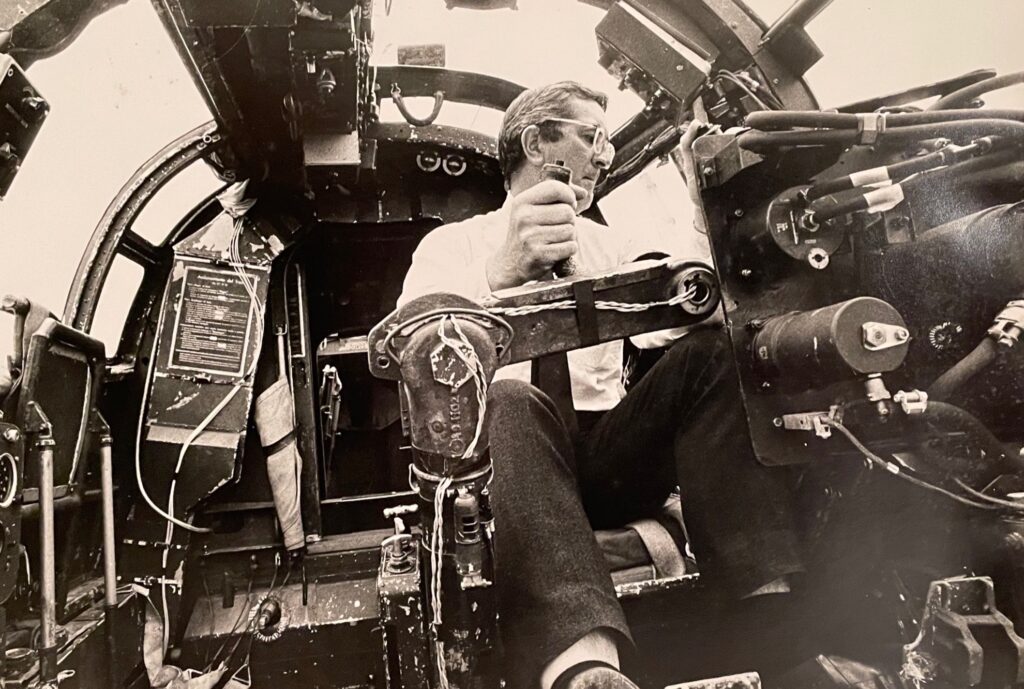
DIVERS
While the first edition of Deighton’s spy novel Horse Under Water, published by Jonathan Cape in 1963, contains many action scenes centring on the discovery of a U-Boat sunk off the Portugese coast in the last days of WWII, it is in the paperback edition, published by Penguin, that the author introduced an additional early episode, in which the British agent trains as a scuba diver at the HMS Vernon base in Portsmouth. As always, Deighton carried out detailed research before writing, managing to get permission to go to Portsmouth and not only witness navy divers undergoing training, but to experience what it was like for himself:

Adrian Flowers accompanied Deighton on this trip to Portsmouth, photographing both the author and navy divers. For Flowers, it was in many ways a homecoming, as his mother’s uncle Alfred West, a photographer and pioneering cinematographer at the turn of the twentieth century, had specialised in photographing and filming the Royal Navy. In 1898, West had photographed torpedo practice in Portsmouth. He also filmed Charles Parsons’ experimental steamship Turbinia, and gave demonstrations of his films at Osborne House. In 1913 he sold his yachting negatives to Beken of Cowes (they are now with the Brett Gallery) but most of his films, made under the ‘Our Navy’ title, are now lost. Adrian’s childhood was spent at “Atherstone” on St. David’s Road, just ten minutes’ walk from Alfred West’s photography studios at Palmerston Road, Southsea.
Deighton put his brief training session at Portsmouth to good use. Descriptions of diving occupy much of the first half of Horse Under Water, as various characters compete to gain access to the treasures on the sunken vessel. The plot moves along at bewildering speed, and it is not revealed until the end of the novel that the race to retrieve items from the submarine wreck has been prompted by the existence of a list of people in the UK who were prepared to collaborate in a German occupation of Britain. This theme of betrayal, touched upon in many of Deighton’s novels and short stories, forms the basis of his later novel SS GB. In Horse Under Water, it is revealed that the former Royal Navy officer ‘Fernie’, a dodgy character who gets involved in the submarine dives, had been earlier recruited into the ‘League of St. George’, influential people who hoped to form a Nazi Party in Britain. As always, Deighton brings his narrative to life with vivid descriptions of people and places, as befits his experience as an illustrator. He also introduces lively references to 1960’s music and consumer culture, including Miles Davis, Charlie Mingus, Tio Pepe Sherry, Omo washing powder etc. Although Adrian Flowers’ photograph of the actor Michael Caine is used in the Penguin edition cover, Horse Under Water was never made into a film.
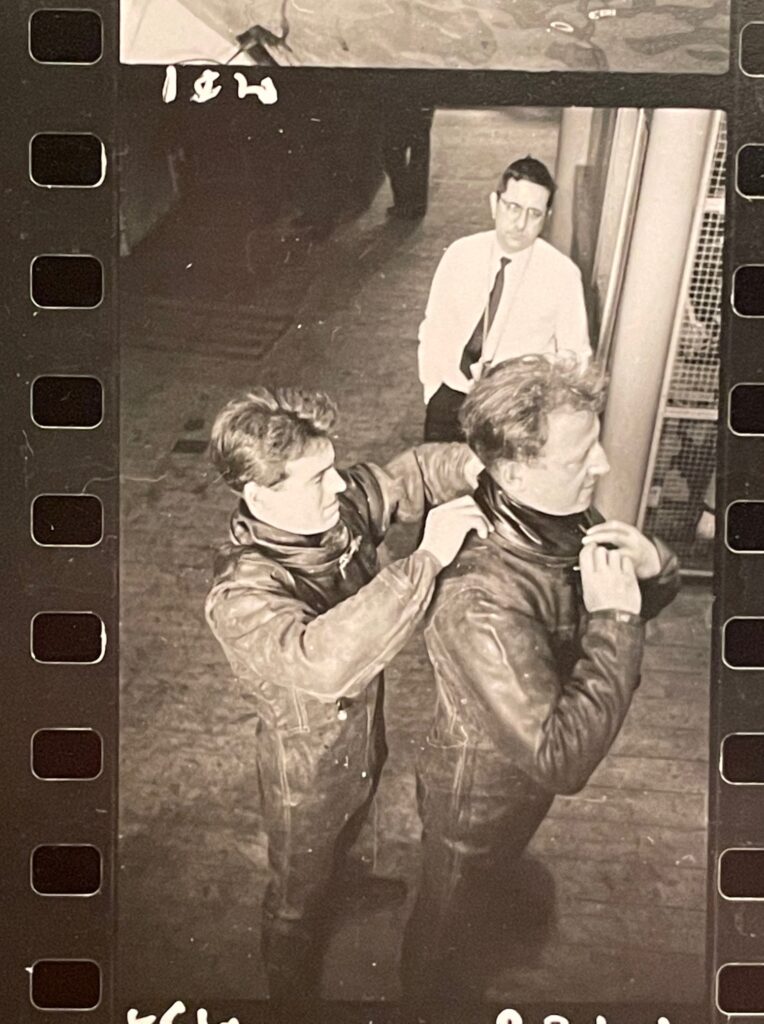


BOMBERS AND FIGHTERS
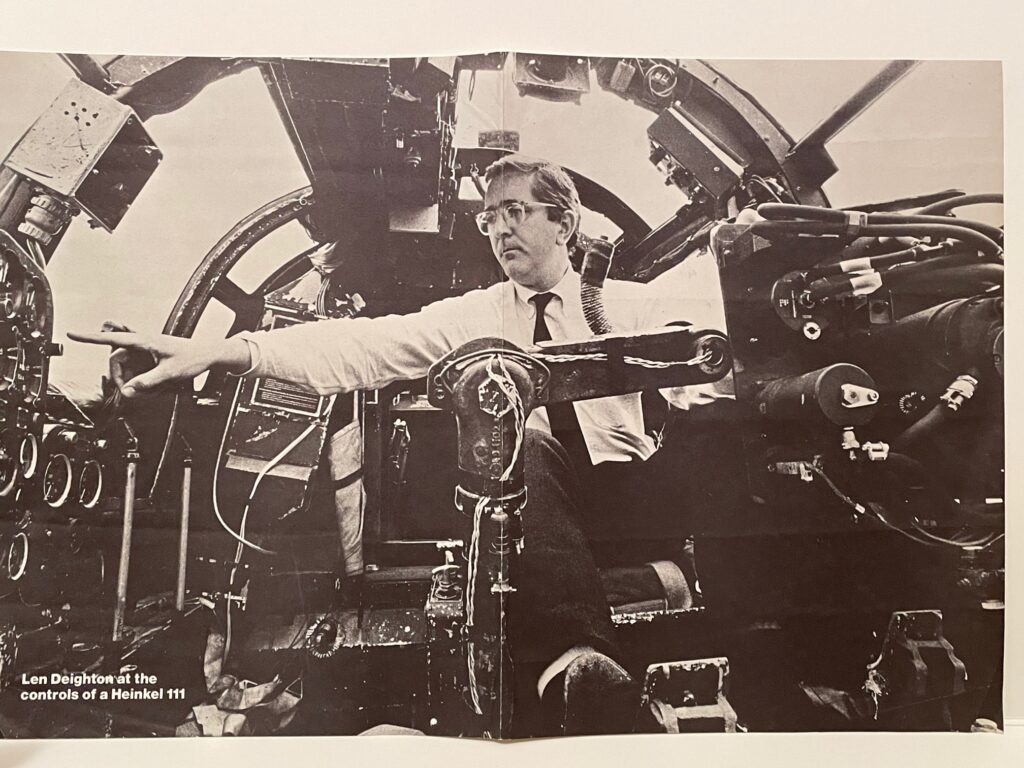
On 3 Jan 1971, in The New York Times, Len Deighton reviewed an autobiographical account by Peter Townsend of the Battle of Britain and the events leading up to it, in which Townsend described an aerial duel between a Hurricane fighter and a Heinkel III bomber. Two years before, when working on Bomber, his own dramatised account of an RAF night attack during WWII, Deighton had carried out detailed research on aircraft of the period, particularly the Heinkel III. On August 15 1969, he was invited to join the crew in a restored Heinkel which was being flown from England to Siegerland airfield, near Cologne. The aircraft was in fact a post-war machine, one of several hundred built under license by CASA for the Spanish air force. Thirty or so of these Spanish Heinkels were used in the 1969 film The Battle of Britain. Although it was planned to fly the Heinkel over the city of Cologne as a promotion for the film, this publicity stunt was cancelled, not least because many of the inhabitants had died in air raids by the RAF during WWII. The following year, after a few demonstration flights, the Heinkel was grounded at Siegersland for safety reasons. It was subsequently acquired by the Deutsches Museum and is now fully restored and on display in the Flugwerft Schleissheim—but with Spanish air force rather than Luftwaffe livery.


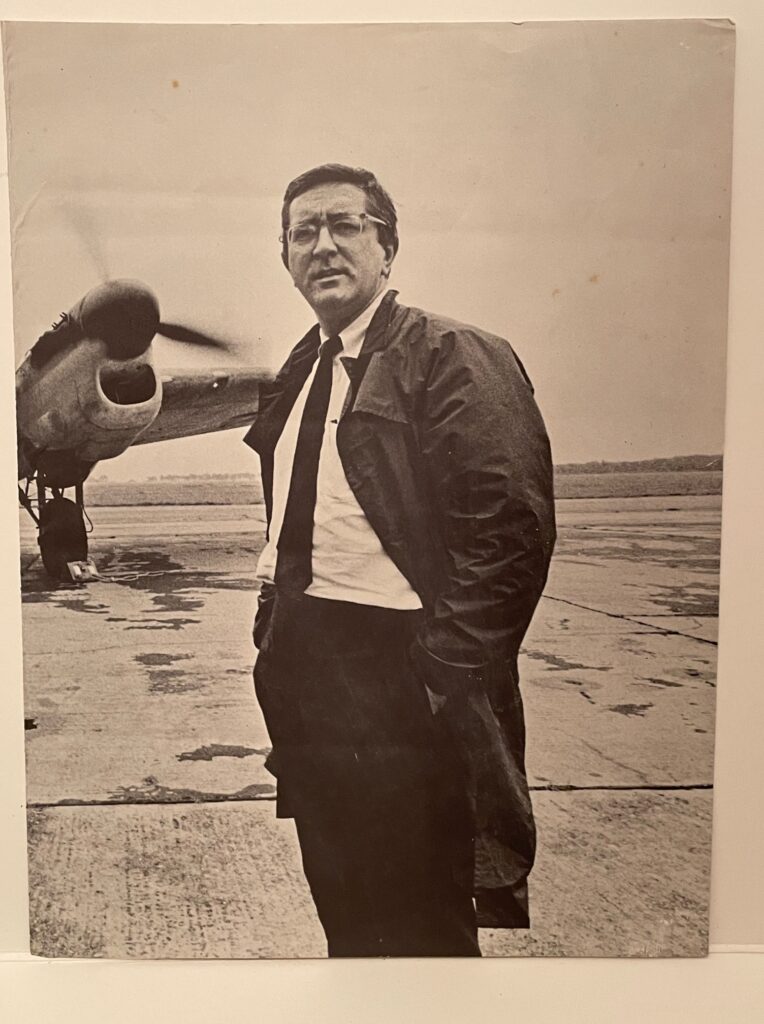
Before the flight took off on August 15th, Adrian Flowers photographed Deighton, both standing in front of the Heinkel, and also inside the cockpit. The research undertaken by Deighton during this period informed his writing of Fighter, published in 1977. One of the chapters in Fighter is titled “Inside a Heinkel He III”.
While working on Bomber, Deighton leased from IBM a new device called an MT/ST (Magnetic Tape Selectric Typewriter)—an early word-processor—and had it installed in his home in Merrick Square, near Elephant and Castle. Adrian Flowers photographed Deighton in his home office, surrounded by typewriters, the IBM word processor and filing cabinets. Although he surrounded himself with high technology, some of the energy evident in Deighton’s prose style may derive from the down-to-earth fact that he liked to write while standing rather than sitting.

Text: Peter Murray
Editor: Francesca Flowers
All images subject to copyright.
Adrian Flowers Archive ©
Constructionist artist
April 1930 – October 2020

Adrian Flowers: job no. 2025 June 1956 Anthony Hill (1930-2020), artist
Famed for its spielers, houses of ill-repute and establishments such as the Coach and Horses and l’Escargot, Greek Street is still today the centre of London’s bohemian quarter. Extending from Soho Square to Shaftesbury Avenue, over the centuries the street had been home to many artists, including Canaletto, Peter Turnerelli, Thomas Lawrence, Richard Westall and William Etty. In 1956, the artist Anthony Hill had a studio on Greek Street, where he was completing a series of abstract ‘concrete’ paintings and wall-mounted reliefs, in preparation for the forthcoming This is Tomorrow exhibition at the Whitechapel Art Gallery. (The term ‘concrete’ describing abstract works that refer to themselves rather than to external reality). In June of that year Adrian Flowers visited Hill’s studio, to photograph the artist and his work. The shots taken that day show that Hill was moving away from conventional oil paintings, preferring instead to make three-dimensional relief paintings/sculptures, using modern materials such as Perspex and aluminium. One of the works that appears in a Flowers’ photograph, Painting 55-56 (Tate collection) was among the last oil paintings made by the artist. Hill described this work as a study in texture and reductionism, with horizontal lines suggesting the canvas was bound by bands. However the photographs taken in 1956 by Flowers inadvertently—or perhaps deliberately—provide a gentle critique of the concept of ‘concrete’ paintings, in that one shot on the contact sheet shows two square windows of the Greek Street studio, with simple astragals, while the next is of Hill’s geometric abstract paintings with their slender cross-bars motifs. Not only did Flowers photograph the paintings, he also took a series of shots of Hill and his collaborator, sculptor John Ernest, standing over a set of free-standing modular cube-like structures. Hill and Ernest were both keen mathematicians, and worked together on ‘crossing number’ in graph theory, an area of research that directly informed Hill’s art.
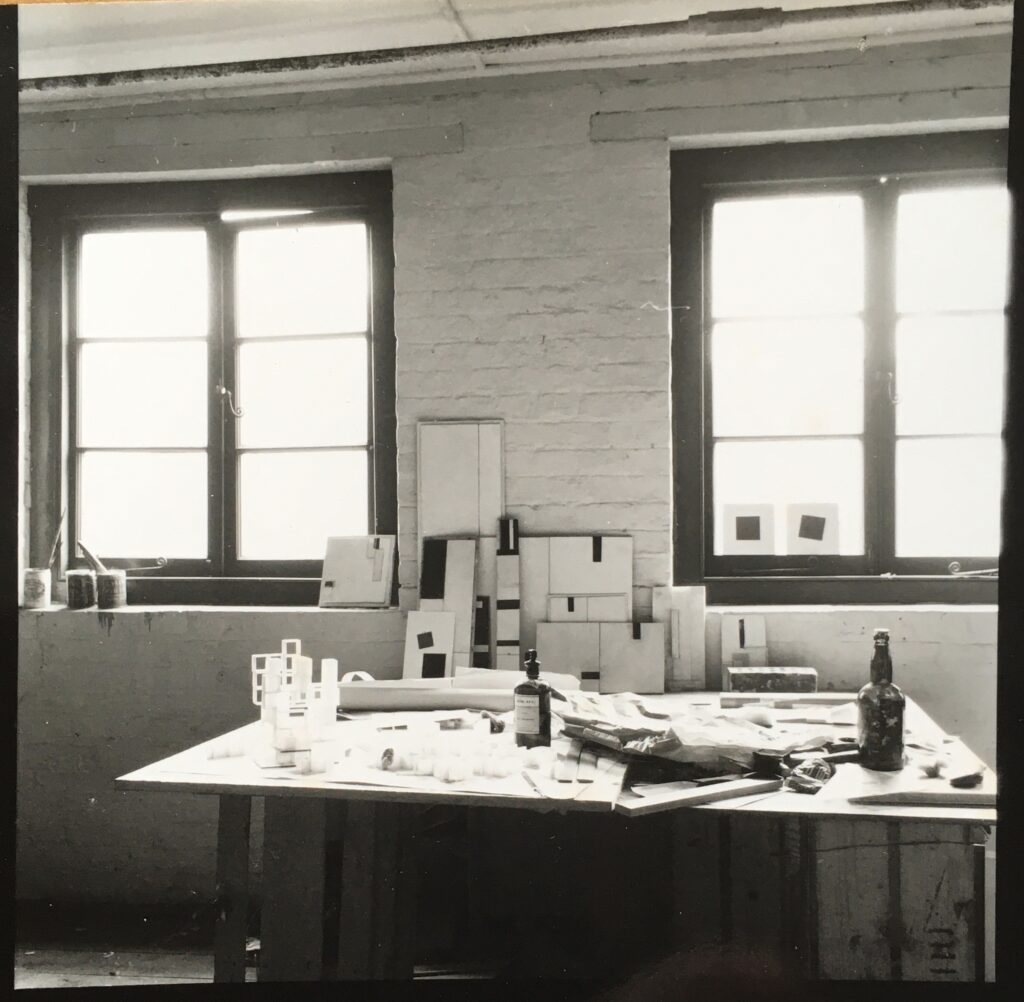
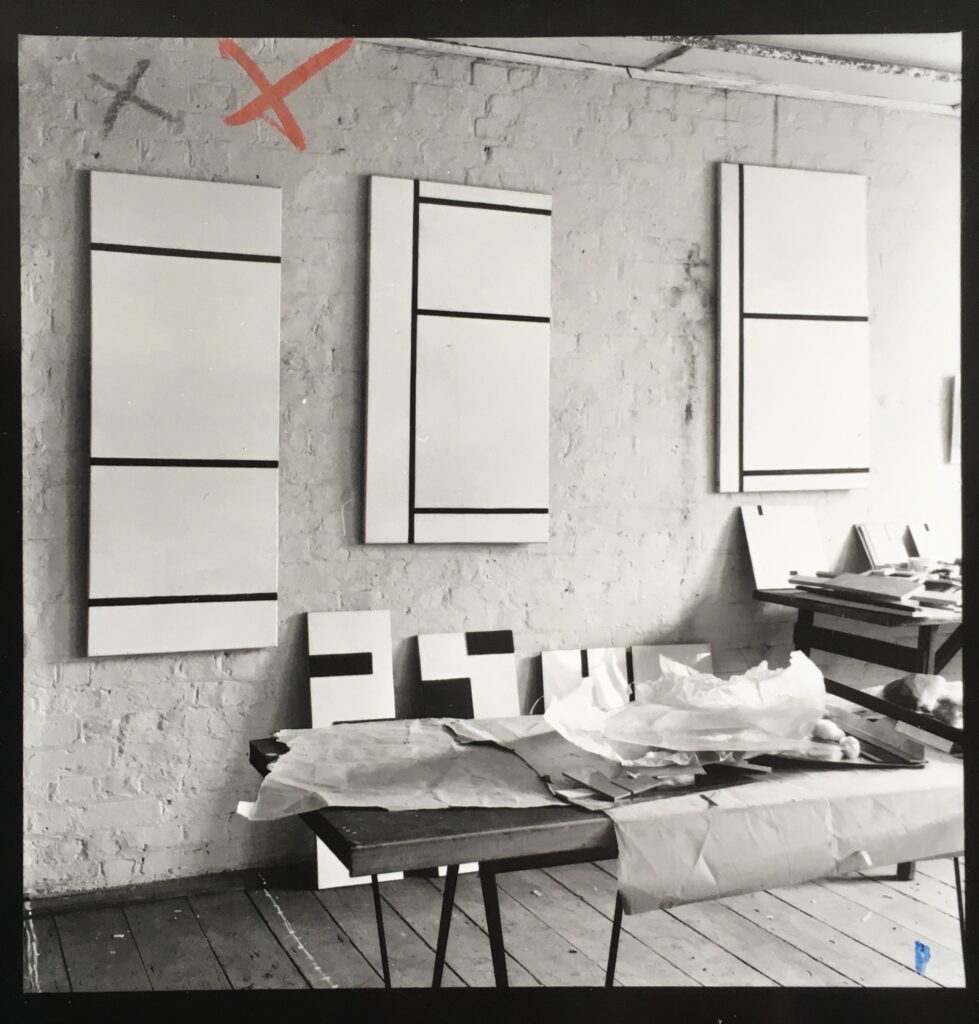
Born in 1930 in London, from an early age Hill was fascinated, and indeed obsessed, by mathematics. At the age of seventeen he enrolled as a student at St. Martin’s School of Art, moving on two years later to the Central School. Initially working in a Dada and Surrealist style, his interest in mathematics led him to become interested in geometric abstraction, which he felt represented a more rational aesthetic. Visiting Paris in early 1950, he met Sonia Delaunay, George Vantongerloo (a founder member of De Stijl) and Francis Picabia. Another artist who influenced him was Frantisek Kupka, of the Orphic Cubism movement. Hill was particularly inspired by Piet Mondrian’s work and the following year joined the “Constructionist Group”, a late offshoot of the Constructivist movement associated with revolutionary Russia. Other members included Kenneth and Mary Martin, Adrian Heath, Roger Hilton, William Scott, Victor Pasmore and Robert Adams—the latter two were at the Central School at the same time as Hill. Publishing a manifesto-like Broadsheet that same year, the group showed their work both at Gimpel Fils and the AIA Gallery, in exhibitions entitled British Abstract Arts and Abstract Paintings Sculptures Mobiles respectively. The Constructionists were not working in a vacuum, but were in touch with artists on the Continent, including Marcel Duchamp, the Swiss abstractionist Max Bill, and the American abstract painter Charles Biederman. They avidly read Biederman’s 1948 treatise, Art as the Evolution of Visual Knowledge.
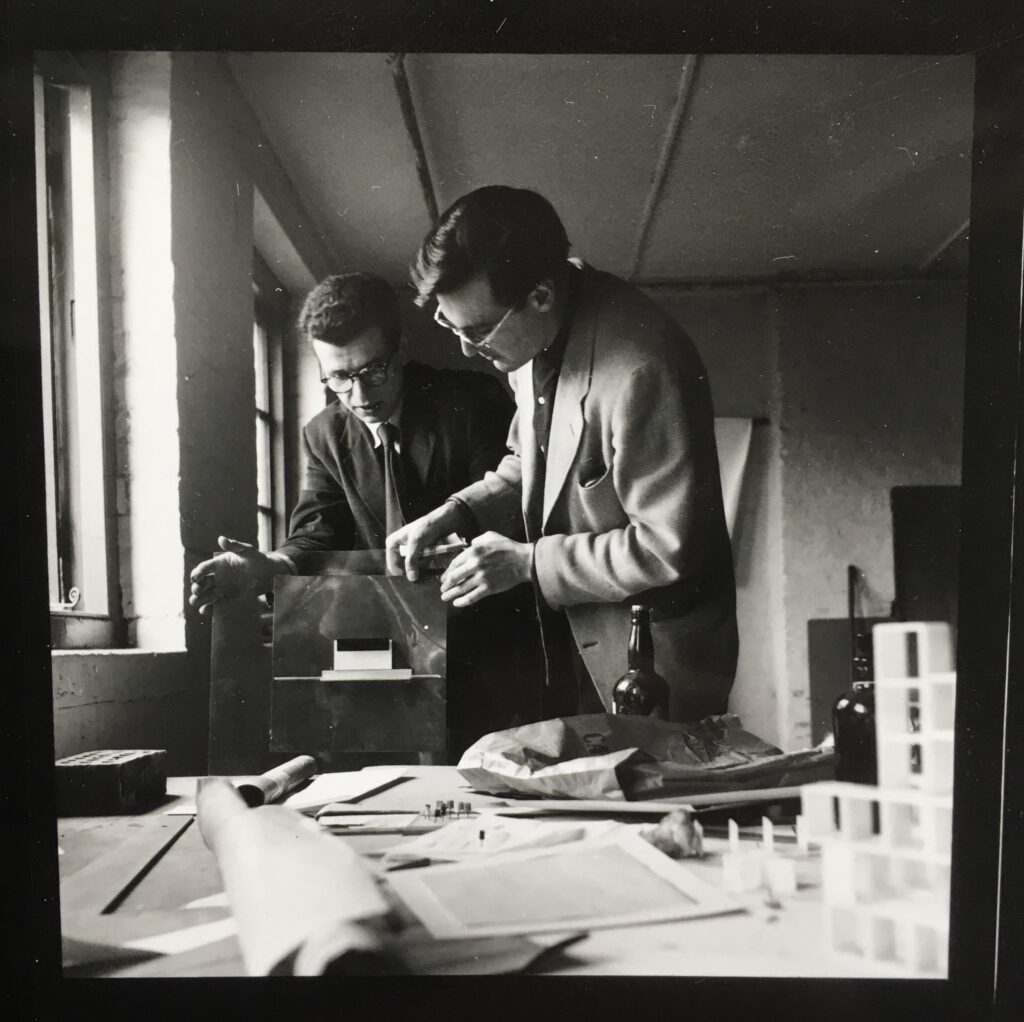
The Constructionists epitomised the search for a Modernism that would be viable within the complex aesthetics of post-war Britain. Although he had been making geometrically-based collages for some time, in 1952 Hill made his first abstract relief. By 1953, he had abandoned colour, and was making stark black and white paintings, in which geometry and free-form drawing were held in tension. A large painting (now lost) Catenary Rhythms was included in the exhibition Artist versus Machine held at the Building Centre, London, in 1954. That same year, along with Stephen Gilbert and others, Hill featured in Lawrence Alloway’s Nine Abstract Artists, a book which sought to distinguish between ‘genuine’ abstract art, and the more or less random styles adopted by those who had rejected figurative art, but who Alloway felt followed no coherent aesthetic. Alloway’s preference for ‘structural’ artists such as Hill, William Scott, Terry Frost and Kenneth and Mary Martin, was based on a conscious opposition to the expressive abstraction epitomised by Peter Lanyon and other St. Ives artists. The group showed at the Redfern Gallery in 1955, with a catalogue written by Hill and the following year were given prominence in the Whitechapel exhibition This is Tomorrow. Adrian Flowers was a steady presence at the centre of this ferment of creativity, photographing the artists in their studios as they prepared their work for exhibition.

After the Whitechapel exhibition, Hill gave up painting entirely, concentrating instead on three-dimensional work. In 1958 his reliefs were shown at the ICA, by which time he was incorporating sheet copper, brass, zinc and stainless steel in these wall-mounted works. The following year Hill and Gillian Wise, another graduate of the Central School of Art, became partners, and in 1962, Hill organised the exhibition Construction: England: 1950-60 at the Drian Gallery, a space founded by the Lithuanian Halima Nalecz, to represent artists excluded from West End Galleries. This was to be the last group exhibition of the Constructionists, and apart from the support of a small band of loyal curators and collectors, they faded from view. Hill and Wise went on to collaborate on works, including Metal Relief with Horizontal Elements (1962) now in the National Galleries of Scotland. In 1963 the couple showed in the exhibition Reliefs/Structures at the ICA.
Based on a high-minded aspiration towards an art that was self-referential and bore no relationship to the world of visible reality, Hill’s aesthetic was intellectual and personal. His often dogmatic assertion of the primacy of this approach led him to write theoretical essays, to explain his approach to making art. However, even within the rarefied world of mathematics, assertions of neutrality were not possible, and Hill’s art and writings can be read today as polemical, personal and even combative assertions regarding society, aesthetics, and the politics of his time. In 1968 Faber and Faber published Data: Directions in Art, Theory, and Aesthetics, a compilation of essays edited by Hill that consciously echoed the 1938 publication Circle, which had featured Naum Gabo, Ben Nicholson and others. Hill’s introductory essay, reflecting his own rigorous approach to making art, was entitled “Programme, Paradigm and Structure”. The following year, led by Jeffrey Steele, a number of UK artists working in this mode formed the “Systems Group”. Less committed to Marxist ideologies, Kenneth and Mary Martin, along with Hill, preferred not to become involved. However Wise, who had been researching Russian Constructivism in the Soviet Union, did join, and eventually this led to her breaking with Hill, who went on to pursue his own career. He subsequently married the Japanese ceramic artist Yuriko Kaetsu (1953-2013). In 1983 he had a retrospective exhibition at the Hayward Gallery and by the early 1970’s was making free-standing geometric constructions. In 1973-4 he adopted the name Achill Redo, under which moniker he exhibited at the Mayor Gallery and Angela Flowers Gallery, and wrote texts that pay homage to the Dadaists and Surrealists. In 1994 his Duchamp anthology Duchamp: Passim was published by Gordon and Breach. In 2012, he was included in the exhibition Concrete Parallels in Sao Paulo, Brazil. By this time, Hill was suffering from bouts of depression that sometimes made it impossible for him to welcome visitors to his studio, and was retreating into an intellectual and personal universe not unlike that of Humphrey Earwicker in James Joyce’s Finnegan’s Wake.
“I asked LSC for a kick-start idea for do it. He gave me his take, but insisted I don’t credit him or refer to him by name. But I have done it. Lafcadio Svensen Carner, he said the short auteur’s cut was not to do it, to do nothing, i.e., it is not a thing you can overtly do. (How do they do it, these megamind pscientists?) They will never finally, really succeed in doing it when it = the grand theory about every it/thing. Best to switch to art, especially abstract art or pure absolutart—that’s where to aim (or aim to miss, as several stratagists convey). Re: doing it right, LSC said, “I could only come up with, you can either do it right or wrong, there is no tertium whatshit. (i.e. excluturd middleterm), there is the theologic of it. That and O’Kamm’s shaver, to the restcu.” (Achill Redo 2012)
Although characterised as an artist who championed rational intellect over emotional feeling, and methodical planning over spontaneous expression, Anthony Hill’s work reveals not only a love of mathematics, but also an appreciation of the intuitive nature of art making. His work was informed by the development of computer language, with its emphasis on logic and patterns of connectivity, and he was equally immersed in the ebb and flow of 20th century art movements, such as De Stijl and the Russian Constructivists, but ultimately there is a personal introspective quality in his art that reveals the extent to which he was on an increasingly solitary quest, exploring philosophical questions on the nature of human consciousness and apprehension of the world.
Anthony Hill died in October 2020

Text by Peter Murray
Editor: Francesca Flowers
All images subject to copyright
Adrian Flowers Archive ©